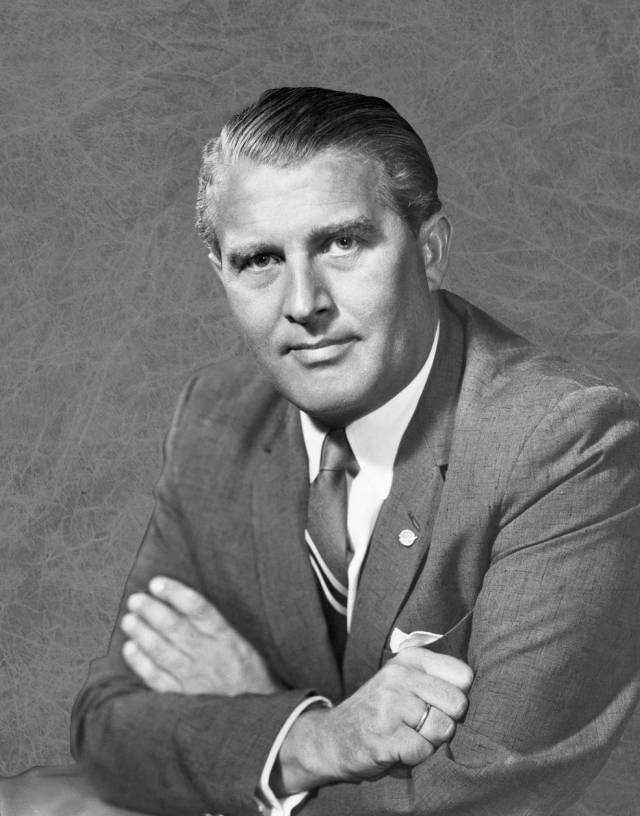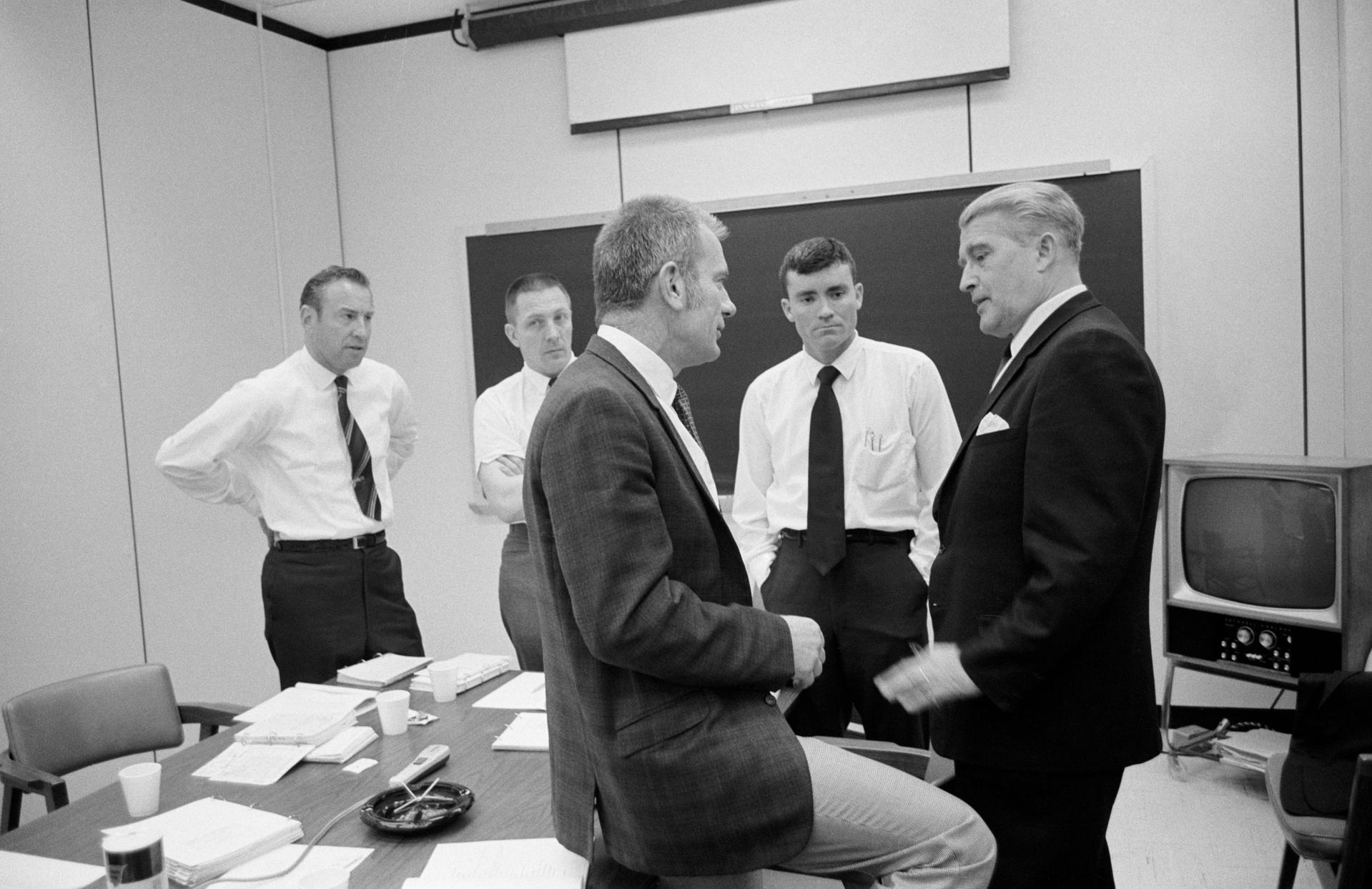
Wernher von Braun
Former Marshall Space Flight Center Director
Dr. Wernher von Braun (1912–1977) was one of the most important rocket developers and champions of space exploration in the twentieth century. As a youth he became enamored with the possibilities of space exploration by reading the work of Hermann Oberth, whose 1923 book The Rocket into Interplanetary Space, prompted von Braun to master calculus and trigonometry so he could understand the physics of rocketry. From his teenage years, von Braun had held a keen interest in space flight, becoming involved in the German Society for Space Travel (VfR) in 1928. As a means of furthering his desire to build large and capable rockets, in late 1932 he went to work for the German army to develop liquid-fuel missiles. Based on his army-funded research on liquid-propellant rocketry, von Braun received a doctorate in physics on July 27, 1934, from the main university in Berlin. Von Braun was a member of an SS equestrian unit in 1933–34, joined the Nazi Party in 1937 and became a junior SS officer in 1940.

The V–2 ballistic missile, the antecedent of U.S. and Soviet intercontinental ballistic missiles and space launch vehicles, was the primary brainchild of von Braun’s rocket team. After 1937 they worked at a secret laboratory at Peenemünde on the Baltic coast. A liquid propellant missile 46 feet in length and weighing 29,000 pounds, the V-2 flew at speeds in excess of 3,500 miles per hour and delivered a 2,200-pound warhead to a target 200 miles away. First successfully launched in October 1942, it was employed against targets in Western Europe, including London, Paris, and Antwerp, beginning in September 1944.
Following Royal Air Force bombing of Peenemünde on the night of 17–18 August 1943, the Nazi leadership made the decision to move production to a new underground facility. This V-2 assembly plant, called the Mittelwerk, was in central Germany near Nordhausen, utilized enslaved labor from the attached Mittelbau-Dora concentration camp. Outfitting the underground facilities began in 1943 with production beginning late 1944. Brutal conditions in the underground facility led to a high mortality rate among the laborers. Though he remined at the test facility at Peenemünde almost to the end of the war, von Braun later testified (1969) to have traveled to the Nordhausen area around 15 times between the late 1943 and February 1945. These typically one-day visits involved trips to the Mittelwerk to communicate changes in V-2 design and final acceptance criteria resulting from continued testing at Peenemünde. Von Braun was well aware of the terrible conditions and was involved in decision-making about the use of slave labor. The camp was liberated by American forces in April 1945.
» More information on the V-2 facility at Dora-Mittelbau
By late 1944, it was obvious to von Braun that Germany would be defeated and occupied, and he began planning for the postwar era. Before the Allied capture of the V–2 rocket complex, von Braun was sent south, eventually to Bavaria. He surrendered to the Americans in the Austrian Alps, along with other key team leaders. For 15 years after World War II, Von Braun worked with the U.S. Army in the development of guided missiles. As part of a military operation called Project Paperclip, he and an initial group of about 125 were sent to America where they were installed at Fort Bliss, Texas. There they worked on rockets for the U.S. Army and assisted in V-2 launches at White Sands Proving Ground, New Mexico.
In 1950 von Braun’s team moved to the Redstone Arsenal near Huntsville, Alabama, where they designed the Army’s Redstone and Jupiter ballistic missiles, as well as the Jupiter C, Juno II, and Saturn I launch vehicles. A Jupiter C orbited the first U.S satellite, Explorer I, in 1958. Von Braun also became one of the most prominent advocates for space exploration in the United States during the 1950s, writing numerous books and several articles for magazines such as Collier’s. Von Braun also served as a spokesman for three Walt Disney television programs on space travel, Man in Space.
In 1960, President Eisenhower transferred his rocket development group at Redstone Arsenal from the Army to the newly established National Aeronautics and Space Administration (NASA). Its primary objective was to develop giant Saturn rockets. Accordingly, von Braun became director of NASA’s Marshall Space Flight Center and the chief architect of the Saturn V launch vehicle, the superbooster that would propel Americans to the Moon. At Marshall, the group also worked on the Mercury-Redstone, the rocket that sent the first American astronaut, Alan Shepard, on a suborbital flight on May 5, 1961. Shortly after Shepard’s successful flight, President John F. Kennedy challenged America to send a man to the Moon by the end of the decade. With the July 20, 1969 moon landing, the Apollo 11 mission fulfilled both Kennedy’s mission.

In 1970, NASA leadership asked von Braun to move to Washington, D.C., to head up the strategic planning effort for the agency. He left his home in Huntsville, Alabama, but in 1972 he decided to retire from NASA and work for Fairchild Industries of Germantown, Maryland. He died in Alexandria, Virginia, on June 16, 1977.

























